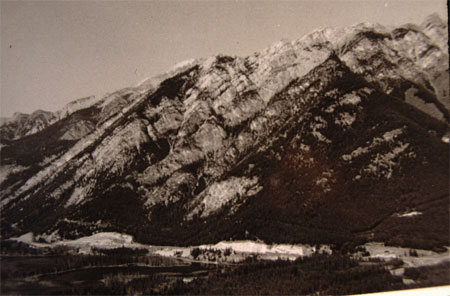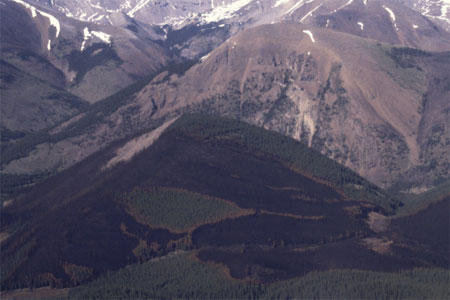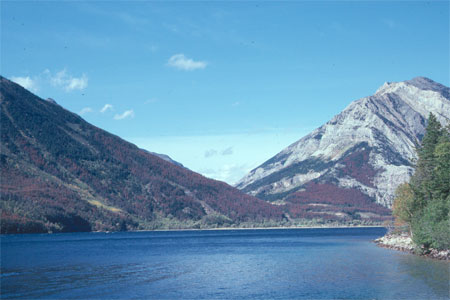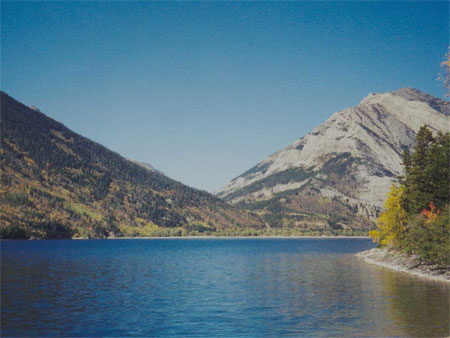Why are there so many beetles right now?
 |
Mountain pine beetle are a natural part of the southern Rocky Mountain ecosystem and have historically existed at endemic levels. This means that there is a normal, small population that is prevented from getting too large by natural factors like climate, predation and fire. Decades of fire suppression and climatic warming trends have helped beetle populations grow from endemic to epidemic proportions.
 |
Dr. Allan Carroll of the Canadian Forest Service explains why:
"Pine forests in general, and in particular lodgepole pine forests, are historically of fire origin. Normally, these forests burn down and regrow and in fact they do it with a fair amount of frequency. We expect lodgepole pine, on average, to burn down and regrow every hundred or so years on a long, broad average. This has been a very effective thing and in fact it has made sure that the forest has been very variable over time because this means that bits and pieces of the forest burn down and regrow and as a consequence, we don’t have a lot of old pine. Now, this is where the mountain pine beetle enters the scenario, because what has happened is through our own fire suppression techniques, we have taken forest fire largely out of the equation and allowed the forest to grow and become old over large areas; and as a consequence, this means that mountain pine beetle has got a large food source because it likes old trees. So, given that we’ve taken forest fire out of the picture, it means that we’ve made a lot more food for the mountain pine beetle."
 Mount Norquay 1902 in Banff National Park.
Mount Norquay 1902 in Banff National Park.© Detroit Photo (1902) |
 Mount Norquay slopes with significant vegetation expansion due to fire suppression.
Mount Norquay slopes with significant vegetation expansion due to fire suppression.© Cliff White (1984) |
 Forest Fires in Kootenay National Park.
Forest Fires in Kootenay National Park.© Parks Canada / Brad White |
The role of fire
Beetles thrive on mature, large pine trees. Partly as a result of fire suppression, large patches of mature pine forests now dominate the landscape. Left to burn, fires tend to create a mosaic of forest patches of various species, ages and densities. This makes the landscape as healthier, and less susceptible to widespread beetle outbreaks.
 Fire creates a mosaic of burned and unburned patches in the forests of the Panther Valley, Banff National Park.
Fire creates a mosaic of burned and unburned patches in the forests of the Panther Valley, Banff National Park.© Parks Canada / Ian Pengelly |
Why do beetles like large, mature pine trees?
Large, mature pine trees are preferred by mountain pine beetle because:
- They are generally bigger and easier for the beetles to find.
- The large size means more beetles can live there, and there is more room for young to develop.
- Older pine trees are less resistant to mountain pine beetle colonization.
- The bark is thicker and offers more protection from the weather and predators.
- The phloem (the tree tissue beetles feed on) is thicker, and provides more food.
Mountain pine beetles also like heat! Because of this, Parks Canada has developed a model that predicts areas that receive high levels of heat from the sun. These are the areas where beetle populations are most likely to survive. This model helps Parks Canada manage beetles more effectively.
 A map produced from the model showing the red areas that are susceptible areas to beetle outbreak.
A map produced from the model showing the red areas that are susceptible areas to beetle outbreak.© Parks Canada |
In 1979, half of Waterton Lakes National Park was covered with large, mature pine trees. Between 1979 and 1982, half of the pine in that forest succumbed to mountain pine beetle activity because the pine trees were in perfect condition for an outbreak.
 The slopes of Bertha Mountain during the 1980 mountain pine beetle outbreak.
The slopes of Bertha Mountain during the 1980 mountain pine beetle outbreak.© Parks Canada / Rob Watt |
 Increased forest diversity on the slopes of Bertha Mountain in 2003 after the mountain pine beetle outbreak.
Increased forest diversity on the slopes of Bertha Mountain in 2003 after the mountain pine beetle outbreak.© Parks Canada / Rob Watt |
How does climate change affect beetle populations?
Cold winters have typically been a factor that control the spread of mountain pine beetle, in addition to fire. A warming climate and mild winters have allowed more mountain pine beetle to survive the winter and go on to colonize new trees in the spring. Studies show that warming trends over the past few decades have allowed beetles to move into higher elevation areas and more northerly regions that were once too cold for the beetle to survive. Such is the case in Jasper National Park.
 |
Dr. Allan Carroll of the Canadian Forest Service talks about climate change and mountain pine beetle:
"Right now the mountain pine beetle populations have been restricted to the southern half of British Columbia primarily. And they’ve been restricted because of two aspects of climate. The first is this issue of cold, -40 degrees limiting the distribution of the beetle mostly. The other is a bit more complex and it has to do with cool summertimes. So when the summer temperatures are too cold for the mountain pine beetle to complete its development in a single year, then what happens is, the mountain pine beetle is forced to go into winter, in stages that aren’t ready for wintertime itself so it can suffer a lot of mortality. With climate change, we expect not only for there to be fewer episodes of very cold wintertime temperatures, but also too that summertime temperatures are going to increase. So both of these together are going to allow the mountain pine beetle to move into areas where it hasn’t been previously."
Beetles Migrate?
Local populations of mountain pine beetle can be increased when beetles from nearby outbreaks migrate into the area. Beetles have been known to fly several kilometres during their spring flight to new trees. If caught by the wind, beetles may travel over a hundred kilometres!
When does an outbreak end?
An "Outbreak" is an insect population that goes from endemic to epidemic.
Beetles, like all natural populations, are prone to fluctuations. Their numbers increase when variables are right and they have a lot of food and good habitat. Outbreaks usually continue until conditions become unfavourable. Unfavourable conditions include:
- Loss of food and habitat (for example, beetles may use up all of the large, mature trees in an area, or the trees may be removed by natural processes such as fire).
- Cold temperatures that ensure the young don’t survive the winter.
- Predation by woodpeckers and other predators.
- Competition for food and habitat with other beetles.
 |
Dr. Les Safranyik of the Canadian Forest Service talks about what causes the end of beetle outbreaks:
“The collapse of the outbreaks usually occur from a combination of two factors, one of these which, especially in British Columbia including the mountain parks region as well, is due to extremely cold temperatures; and the other main factor is the depletion of the preferred food resource, and that is the larger diameter component of stands. Towards the end that is, in the declining phase of an infestation, other factors can affect the populations negatively, such as a secondary bark beetle species, which compete with them under the bark for food and space, so they cause mortality or extra mortality which further reduce their numbers.”
Learn more about dispersal and colonization on this Canadian Forest Service web page.
Related links
- Date modified :
